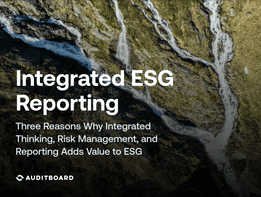The Case for Integrated ESG Reporting: 3 Reasons to Use It
With ESG reporting regulations on the horizon, it’s time to start planning how your organization will meet the requirements. John Wheeler shares why integrated reporting, which connects financial and nonfinancial reporting, offers a more cohesive, transparent, and holistic approach to corporate sustainability reporting.
96% of the S&P 500 and 81% of the Russell 1000 are now publishing a sustainability report — but is this information actually reliable and meaningful?
In addition, these new reporting efforts have created independent cost structures within companies dedicated to managing sustainability and ESG risks in an ad-hoc, fragmented way. Meanwhile, there are many interdependencies between mandatory, regulated financial reporting and what is, at present, voluntary, unregulated ESG reporting. But while most companies issue standalone reports on environmental, social, and governance (ESG) risk topics, separate reports require different reporting processes and additional cost. As investors and other stakeholders strive to understand companies’ ability to create value over time, they’re pressing for more comprehensive corporate reporting that accounts for these interdependencies.
U.S., EU, UK, and global regulators and standard-setters are all looking toward the same solution: integrated reporting, which connects financial and nonfinancial reporting to offer a more cohesive, transparent, and holistic approach to corporate reporting.
By virtue of its recent consolidation of several of the world’s foremost ESG
organizations — including the International Integrated Reporting Council (IIRC), which rolled out the Integrated Reporting <IR> Framework in 2013 — the IFRS Foundation’s International Sustainability Standards Board (ISSB) has taken on the integrated reporting mantle. Momentum is growing, and not simply due to impending regulation. Many businesses are realizing the benefits of the symbiotic relationship between integrating reporting, integrated thinking, and integrated risk management, which come together to support decisions and create efficiencies that drive value creation over time.
John Wheeler, Senior Advisor, Risk and Technology at AuditBoard, outlines:
96% of the S&P 500 and 81% of the Russell 1000 are now publishing a sustainability report — but is this information actually reliable and meaningful?
In addition, these new reporting efforts have created independent cost structures within companies dedicated to managing sustainability and ESG risks in an ad-hoc, fragmented way. Meanwhile, there are many interdependencies between mandatory, regulated financial reporting and what is, at present, voluntary, unregulated ESG reporting. But while most companies issue standalone reports on environmental, social, and governance (ESG) risk topics, separate reports require different reporting processes and additional cost. As investors and other stakeholders strive to understand companies’ ability to create value over time, they’re pressing for more comprehensive corporate reporting that accounts for these interdependencies.
U.S., EU, UK, and global regulators and standard-setters are all looking toward the same solution: integrated reporting, which connects financial and nonfinancial reporting to offer a more cohesive, transparent, and holistic approach to corporate reporting.
By virtue of its recent consolidation of several of the world’s foremost ESG
organizations — including the International Integrated Reporting Council (IIRC), which rolled out the Integrated Reporting <IR> Framework in 2013 — the IFRS Foundation’s International Sustainability Standards Board (ISSB) has taken on the integrated reporting mantle. Momentum is growing, and not simply due to impending regulation. Many businesses are realizing the benefits of the symbiotic relationship between integrating reporting, integrated thinking, and integrated risk management, which come together to support decisions and create efficiencies that drive value creation over time.
John Wheeler, Senior Advisor, Risk and Technology at AuditBoard, outlines:
- Reasons to invest in an integrated approach to solve your ESG challenges.
- How organizations use integrated thinking across five key areas to assess maturity and identify opportunities.
- Tips for getting started with integrated ESG reporting.
Put your organization on a path to begin thinking, managing risks, and ultimately reporting in an integrated manner.

Copyright © 2023. All rights reserved.